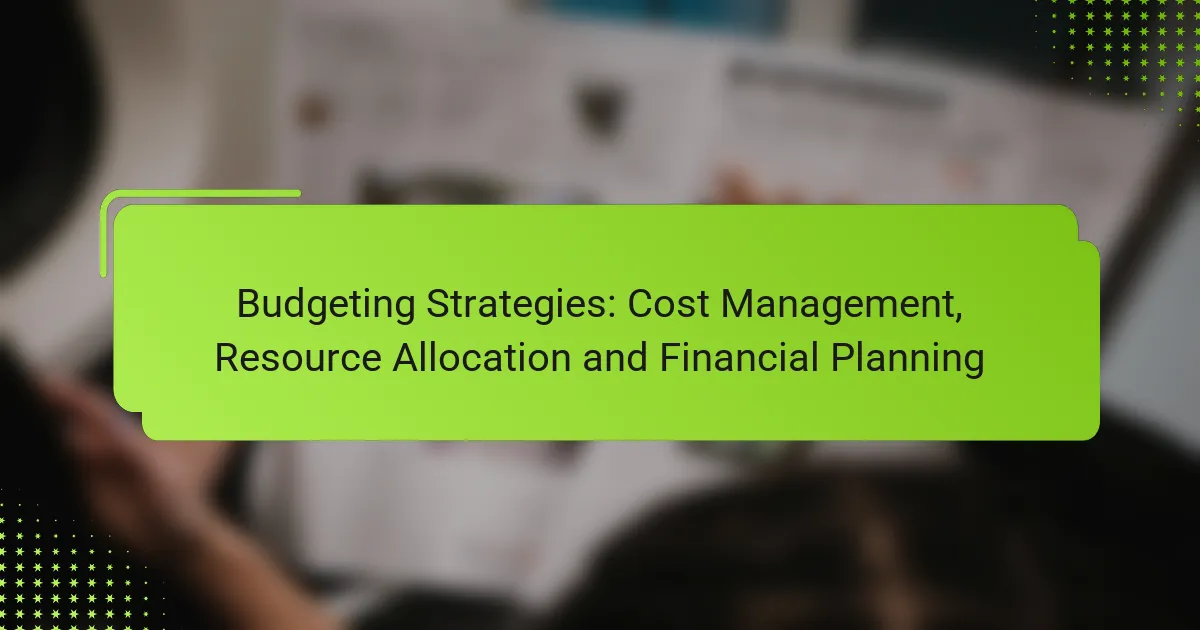Effective budgeting strategies are essential for small businesses to manage costs, allocate resources efficiently, and ensure sound financial planning. By implementing the right techniques, organizations can optimize their financial performance, control expenses, and direct funds towards projects that yield the highest returns, ultimately enhancing profitability and adaptability in a dynamic market.

What are effective budgeting strategies for small businesses?
Effective budgeting strategies for small businesses help manage costs, allocate resources efficiently, and ensure sound financial planning. By selecting the right approach, businesses can optimize their financial performance and adapt to changing market conditions.
Zero-based budgeting
Zero-based budgeting (ZBB) requires that all expenses must be justified for each new period, starting from a “zero base.” This method encourages businesses to evaluate all costs and prioritize spending based on current needs rather than historical data.
To implement ZBB, businesses should identify their goals, assess necessary expenditures, and allocate funds accordingly. This approach can lead to significant cost savings but may require more time and effort to prepare each budget cycle.
Incremental budgeting
Incremental budgeting involves adjusting the previous year’s budget to account for changes in revenue and expenses. This method is straightforward and time-efficient, making it popular among small businesses.
While incremental budgeting is easy to implement, it can perpetuate inefficiencies if past expenditures are not critically assessed. Businesses should regularly review their budget to ensure that all increments are justified and aligned with current goals.
Flexible budgeting
Flexible budgeting allows businesses to adjust their budget based on actual activity levels, such as sales or production volume. This adaptability helps in managing costs effectively in response to changing circumstances.
To create a flexible budget, businesses should establish variable and fixed costs and set benchmarks for different activity levels. This strategy is particularly useful for businesses with fluctuating sales, as it provides a clearer picture of financial performance under varying conditions.
Value proposition budgeting
Value proposition budgeting focuses on aligning spending with the value delivered to customers. This strategy ensures that resources are allocated to initiatives that enhance customer satisfaction and drive revenue.
To apply this method, businesses should evaluate their offerings and identify which expenditures directly contribute to customer value. This approach can lead to more strategic investments and improved customer loyalty, but it requires a thorough understanding of customer needs and preferences.
Activity-based budgeting
Activity-based budgeting (ABB) allocates costs based on the activities that drive expenses, rather than traditional line items. This method provides a more accurate reflection of resource consumption and helps identify cost-saving opportunities.
To implement ABB, businesses should analyze their activities, assign costs to each, and determine how these activities contribute to overall business objectives. While this approach can be complex, it often results in more informed decision-making and better resource allocation.

How can resource allocation improve financial planning?
Resource allocation enhances financial planning by ensuring that funds and assets are directed towards projects that yield the highest returns. By strategically distributing resources, organizations can optimize their budget, minimize waste, and achieve their financial goals more effectively.
Prioritizing high-impact projects
Focusing on high-impact projects is essential for effective resource allocation. Identify initiatives that align with strategic objectives and offer significant returns on investment. For instance, a company might prioritize a new product launch over minor upgrades to existing products, as the former could drive substantial revenue growth.
To determine which projects to prioritize, consider factors such as potential revenue, market demand, and alignment with long-term goals. Regularly reassess project priorities to adapt to changing market conditions and organizational needs.
Utilizing resource management software
Resource management software can streamline the allocation process by providing real-time insights into resource availability and project demands. These tools help track budgets, timelines, and resource utilization, allowing for more informed decision-making.
When selecting software, look for features that support collaboration, reporting, and forecasting. Popular options include tools like Microsoft Project, Asana, or Trello, which can help teams visualize workloads and adjust allocations accordingly.
Implementing a project portfolio management approach
Project portfolio management (PPM) involves evaluating and managing a collection of projects to maximize value and minimize risk. This approach allows organizations to align their projects with strategic objectives and allocate resources more effectively across the portfolio.
To implement PPM, establish criteria for project selection and evaluation, such as return on investment, resource requirements, and strategic fit. Regularly review the portfolio to ensure resources are allocated to projects that deliver the best outcomes, and be prepared to pivot as necessary based on performance and market changes.

What are common cost management techniques?
Common cost management techniques help organizations control expenses and optimize resource allocation. These methods enable businesses to assess financial performance, identify inefficiencies, and make informed decisions to enhance profitability.
Cost-benefit analysis
Cost-benefit analysis (CBA) is a systematic approach to evaluating the financial implications of a project or decision by comparing its costs against the expected benefits. This technique helps organizations determine whether a project is worth pursuing based on its potential return on investment.
To conduct a CBA, list all relevant costs and benefits, assign monetary values, and calculate the net benefit. A positive net benefit indicates that the benefits outweigh the costs, making the project viable. For example, if a new software implementation costs $50,000 but is expected to save $70,000 annually, the CBA supports moving forward.
Benchmarking
Benchmarking involves comparing a company’s performance metrics to industry standards or best practices from other organizations. This technique helps identify areas for improvement and sets performance targets based on successful peers.
To effectively benchmark, select key performance indicators (KPIs) relevant to your industry, such as cost per unit or operational efficiency. Analyze the data to pinpoint gaps and develop strategies to close them. For instance, if your company’s production cost is higher than the industry average, investigate the reasons and implement cost-saving measures.
Variance analysis
Variance analysis is the process of comparing actual financial performance to budgeted figures to identify discrepancies. This technique helps organizations understand why costs differ from expectations and enables corrective actions to be taken.
To perform variance analysis, calculate the difference between actual and budgeted amounts for various cost categories. Investigate significant variances to determine their causes, such as unexpected expenses or revenue shortfalls. For example, if actual expenses exceed the budget by 15%, analyzing the underlying factors can help prevent similar issues in the future.

How to create a budget for a startup?
Creating a budget for a startup involves outlining expected expenses and projected income to ensure financial stability. This process helps entrepreneurs allocate resources effectively and plan for future growth.
Estimating initial costs
Estimating initial costs is crucial for a startup budget. Begin by identifying all necessary expenses, such as equipment, office space, and legal fees. These costs can range from a few thousand to several hundred thousand dollars, depending on the industry and scale of the business.
Break down these costs into fixed and variable categories. Fixed costs, like rent, remain constant, while variable costs, such as marketing, can fluctuate. This distinction helps in managing cash flow effectively.
Identifying revenue streams
Identifying revenue streams is essential for understanding how your startup will generate income. Consider various sources such as product sales, subscription services, or advertising revenue. Each stream should be evaluated for its potential profitability and sustainability.
Conduct market research to gauge demand and pricing strategies. This will help in forecasting revenue more accurately, allowing you to adjust your budget accordingly. Aim for a diverse range of revenue sources to mitigate risks.
Setting financial goals
Setting financial goals provides direction for your startup’s budgeting process. Establish short-term objectives, such as reaching a specific sales target within the first year, and long-term goals, like achieving profitability within three to five years.
Make these goals SMART: Specific, Measurable, Achievable, Relevant, and Time-bound. Regularly review and adjust your financial goals based on performance and market conditions to stay on track and ensure growth.

What are the benefits of financial forecasting?
Financial forecasting provides organizations with a roadmap for future financial performance, helping to anticipate revenue, expenses, and cash flow needs. By projecting future financial outcomes, businesses can make informed decisions that align with their strategic goals.
Improved cash flow management
Effective financial forecasting enhances cash flow management by predicting inflows and outflows over specific periods. This allows businesses to identify potential shortfalls and take proactive measures, such as securing financing or adjusting spending.
For instance, a company might forecast a dip in cash flow during a slow sales season, enabling it to reduce discretionary expenses in advance. Regularly updating forecasts can help maintain healthy cash reserves, ensuring operational stability.
Informed decision-making
Financial forecasting supports informed decision-making by providing data-driven insights into future performance. By analyzing trends and potential scenarios, businesses can evaluate the impact of various strategies before implementation.
For example, if a forecast indicates strong growth in a specific market segment, a company might decide to allocate more resources to that area. Conversely, if forecasts predict a downturn, it may choose to delay investments or cut costs. This strategic approach minimizes risks and maximizes opportunities.



